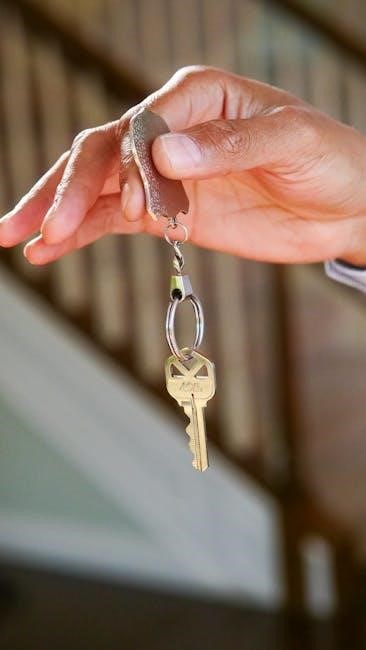Ionic Bonds Worksheet: Understanding the Basics
This worksheet is designed to evaluate student comprehension regarding ionic bonding principles․ It suits grades 7-12, assessing knowledge of electron transfer and stable configurations․ Students will identify ionic compounds, draw Lewis dot structures, and analyze Bohr diagrams to demonstrate understanding․
What is an Ionic Bond?
An ionic bond is a type of chemical bond formed through the electrostatic attraction between oppositely charged ions․ This occurs when one or more electrons are transferred from one atom to another, typically between a metal and a non-metal․ The atom that loses electrons becomes a positively charged ion (cation), while the atom that gains electrons becomes a negatively charged ion (anion)․ This electron transfer is driven by the desire of atoms to achieve a stable electron configuration, often resembling that of a noble gas․ The resulting attraction between the cation and anion constitutes the ionic bond, creating a stable ionic compound․
Worksheet Content Overview
The worksheet comprehensively assesses understanding, featuring sections on identifying metals, non-metals, and metalloids․ It distinguishes ionic from covalent bonds, providing practice in recognizing and classifying different chemical compounds based on their bonding characteristics․
Identifying Metals, Non-metals, and Metalloids
This section of the worksheet focuses on the fundamental skill of classifying elements based on their properties and positions on the periodic table․ Students will learn to differentiate between metals, non-metals, and metalloids, understanding their roles in forming chemical bonds․ The activity involves recognizing characteristics such as conductivity, luster, and electron affinity to categorize elements accurately․ Proficiency in this area is crucial, as the type of element involved directly influences the nature of the chemical bond formed, particularly in the context of ionic versus covalent interactions․ Correct identification forms the foundation for predicting compound properties․
Ionic vs․ Covalent Bond Identification
This segment of the worksheet challenges students to distinguish between ionic and covalent bonds based on the elements involved․ Students will analyze chemical formulas and element properties to determine whether a bond is formed through electron transfer (ionic) or electron sharing (covalent)․ The exercise reinforces understanding of electronegativity differences and their impact on bond polarity․ Students will classify various compounds, such as ammonium chloride or titanium bromide, based on bonding characteristics․ This involves recognizing metal-nonmetal combinations as indicative of ionic bonds and nonmetal-nonmetal combinations as indicative of covalent bonds, solidifying their comprehension of chemical bonding principles and compound nomenclature․

Key Concepts Covered
The worksheet explores electron transfer during ionic bond formation and achieving stable electron configurations․ Students will learn about ion formation and their charges․ These fundamental concepts underpin understanding chemical bonding behavior․
Electron Transfer in Ionic Bond Formation
Ionic bond formation fundamentally involves the transfer of electrons from one atom to another․ Typically, a metal atom donates one or more electrons to a non-metal atom․ This electron transfer results in the formation of ions: positively charged cations (metals lose electrons) and negatively charged anions (non-metals gain electrons);
This transfer occurs because atoms strive to achieve a stable electron configuration, often resembling that of a noble gas․ The electrostatic attraction between oppositely charged ions constitutes the ionic bond, holding the atoms together in a stable compound․ Understanding electron transfer is crucial for predicting ionic compound formation and properties;
Achieving Stable Electron Configurations
Atoms form ionic bonds to attain a stable electron configuration, typically characterized by a full outer electron shell, mirroring noble gases․ This stability is achieved through electron transfer, where atoms either gain or lose electrons to complete their valence shell․
Metals tend to lose electrons to achieve the electron configuration of the preceding noble gas, while nonmetals gain electrons to match the electron configuration of the following noble gas․ This pursuit of stability drives the formation of ions and the subsequent electrostatic attraction that binds them together, creating stable ionic compounds with unique properties․
Formation of Ions and their Charges
Ionic bonds result from the electrostatic attraction between oppositely charged ions․ Metals typically lose electrons, becoming positively charged cations, while nonmetals gain electrons, becoming negatively charged anions․ The charge of an ion is determined by the number of electrons gained or lost to achieve a stable electron configuration․
For instance, sodium (Na) loses one electron to form Na+, while chlorine (Cl) gains one electron to form Cl-․ These resulting ions, with their opposite charges, attract each other, forming the ionic compound sodium chloride (NaCl)․ Understanding ion formation and charge is crucial for predicting ionic compound formulas․

Worksheet Question Types
The worksheet includes questions on drawing Lewis dot structures, writing symbols for elements, and using Bohr diagrams to illustrate electron transfer․ These questions test the student’s ability to visualize and represent ionic bond formation․
Drawing Lewis Dot Structures
Lewis dot structures are a crucial component of the ionic bonds worksheet, serving to visually represent the valence electrons of atoms involved in ionic bonding․ Students will be tasked with accurately depicting the electron transfer process, showing how atoms gain or lose electrons to achieve stable octets․
This section of the worksheet evaluates their understanding of electron distribution and how it leads to the formation of ions․ By drawing Lewis dot structures, students demonstrate their ability to predict the charges of ions and illustrate the resulting ionic compound formed through electrostatic attraction․ This exercise reinforces core concepts․
Writing Symbols for Elements in Ionic Bonds
This section emphasizes the correct notation of elements involved in ionic bonding, a fundamental skill in chemistry․ Students will practice writing the symbols for elements, including their respective ionic charges, after electron transfer․ This exercise reinforces the concept that metals typically lose electrons to form positive ions (cations), while non-metals gain electrons to form negative ions (anions)․
Worksheet questions will require students to accurately represent the resulting ions with their appropriate charges․ Mastering this skill is essential for writing correct chemical formulas for ionic compounds and understanding stoichiometry․ They will also use these symbols in conjunction with Lewis Dot Structures․
Bohr Diagrams and Electron Transfer Arrows
This section focuses on visualizing ionic bond formation using Bohr diagrams․ Students will draw Bohr models representing the electron configurations of atoms before and after electron transfer․ They will use arrows to illustrate the movement of electrons from one atom to another, demonstrating how ions are formed to achieve stable octets․
This visual representation aids understanding of electron transfer․ The problems will involve common ionic compounds․ By drawing electron transfer arrows, students clarify the process of ionization and the resulting charges on the ions․ The Bohr models show the transfer of electrons so both achieve stability․

Answer Key Information
The answer key will provide verified solutions․ It will contain examples of ionic compounds and non-examples, including their electron configurations․ This will help students check their work and understand the concepts thoroughly, reinforcing learning․
Examples of Ionic Compounds
The answer key for the ionic bonds worksheet will feature several examples of ionic compounds, illustrating the transfer of electrons between metals and nonmetals․ Common examples include sodium chloride (NaCl), formed from sodium (Na) donating an electron to chlorine (Cl), and magnesium oxide (MgO), where magnesium (Mg) transfers two electrons to oxygen (O)․ These examples will demonstrate how ions with opposite charges attract to form a stable compound․
Further examples such as potassium iodide (KI), calcium chloride (CaCl2), and lithium fluoride (LiF) showcase a variety of Group 1 and Group 2 metals bonding with halogens․ Each example includes the correct chemical formula and the resulting ionic charges․
Non-Examples of Ionic Compounds
The answer key for the ionic bonds worksheet will explicitly identify compounds that are not formed through ionic bonding․ These non-examples are crucial for students to differentiate between ionic and covalent bonding․ Typically, covalent compounds involve the sharing of electrons between two nonmetals, rather than the transfer of electrons․
Examples of non-ionic compounds include methane (CH4), water (H2O), and carbon dioxide (CO2)․ These molecules consist of nonmetal atoms linked by covalent bonds․ Additionally, substances like diamond (C) and graphite (C), which are allotropes of carbon, and diatomic molecules such as oxygen (O2) and nitrogen (N2) are also not ionic․

Resources for Ionic Bonds Worksheets
Several resources offer ionic bonds worksheets, including CliffsNotes for study guides and Science Spot for middle school materials․ These resources provide lessons, activities, and answer keys to aid in teaching and learning․
CliffsNotes Study Guides
CliffsNotes stands as a well-recognized and widely emulated resource for study guides․ Authored by experienced educators, these guides cater to diverse subjects, offering support for homework challenges and exam preparation․ Established in 1958 by Clifton Keith Hillegass, CliffsNotes has a long history of providing accessible educational content․ These study guides can be invaluable when seeking additional explanations or practice problems related to ionic bonds․ They often include detailed examples and step-by-step solutions, helping students grasp the underlying concepts effectively․ CliffsNotes can be found in libraries, bookstores, and online, making them a convenient and reliable tool for students of all levels․
Science Spot (Middle School Resources)
The Science Spot is a valuable online hub, providing complimentary lessons, activities, and resources tailored for middle school science educators․ Although its last update was in 2014 and scheduled for retirement in 2018, some resources might still prove useful․ While the main website is no longer maintained, archived content could offer supplementary materials related to chemical bonding, including ionic bonds․ Teachers and students might find engaging activities or lesson plans that help illustrate the principles behind electron transfer and the formation of ionic compounds․ Remember to verify the accuracy and relevance of any information sourced from the Science Spot, given its outdated status․
